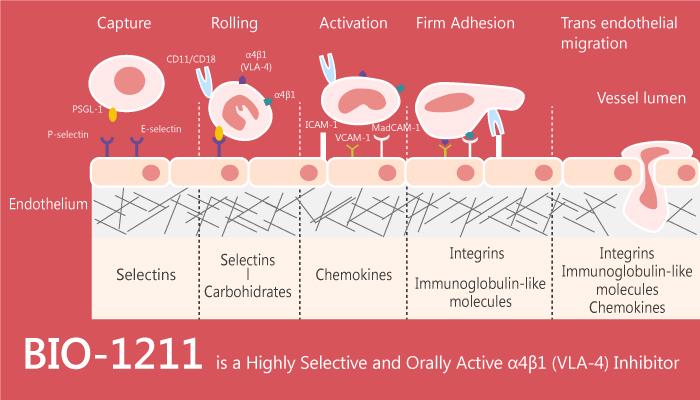Very Late Antigen-4 (VLA4 or CD49d/CD29) is aα4β1 integrin with a pivotal role in controlling immune cell migration into inflamed tissue. Especially, BIO1211 acts as a probe to assess α4β1 function under various states of activation. BIO1211 mimics many of the properties of α4β1 ligands and that the different activation states of α4β1 it distinguishes are indeed relevant to the binding of more physiological ligands. BIO1211 represents potent tools that should aid in further unraveling the complexities associated with integrin activation.
VLA4 appears to be imperative for innate antigen-independent immune responses. BIO-1211 is a very late antigen-4 (biochemical activity of VLA4) blocker. BIO-1211 targets the disruption of VLA4/VCAM1 interactions in mice. The effect results in reduced cytokines expression, leukocyte trafficking, and inhibition of inflammatory responses in encephalomyelitis in a dose-independent manner. BIO-1211 acts a highly active VLA4 antagonist with good bioavailability in rats, dogs, and monkeys.

BIO-1211 is a powerful VLA4 antagonist and displays 200-fold selectivity for the activated form of α4β1 (KD = 70 pM; IC50=4 nM). In addition, BIO-1211 is also selective for α4β1 over a range of other integrins (IC50 >100 μM for α1β1, α5β1 and α6β1). BIO-1211 treatment significantly delays the onset of encephalomyelitis and reduced the severity of clinical encephalomyelitis compared to the vehicle group. Furthermore, BIO-1211 limits the migration of immune cells markers, CD11b, and CD45. BIO-1211 modulates the Localization of IFNγ, IL-17, and TNF-α in the cerebral cortex. Moreover, BIO-1211 decreases the expression of inflammatory cytokines in both protein and mRNA levels.
All in all, BIO12-11 is a useful tool to further understand the biological roles of VLA4/VCAM1 interactions and can be as an encephalomyelitis-suppressing agent.